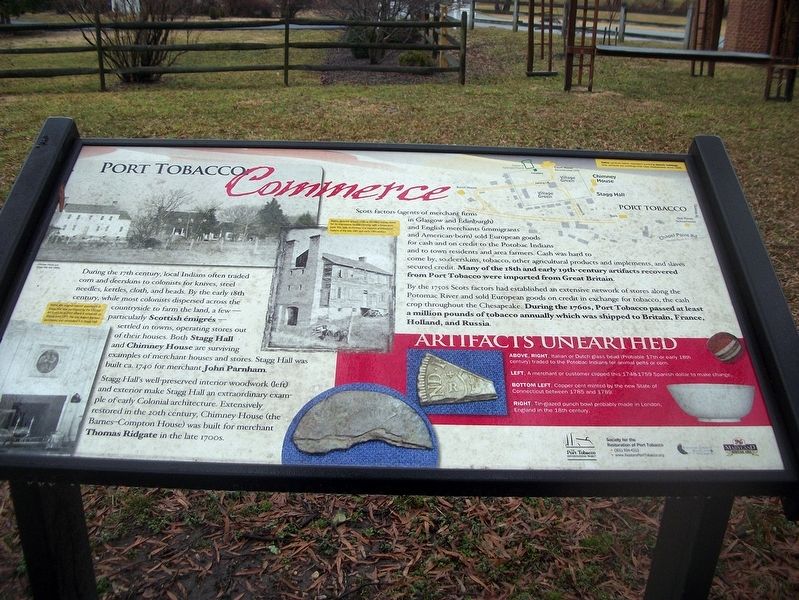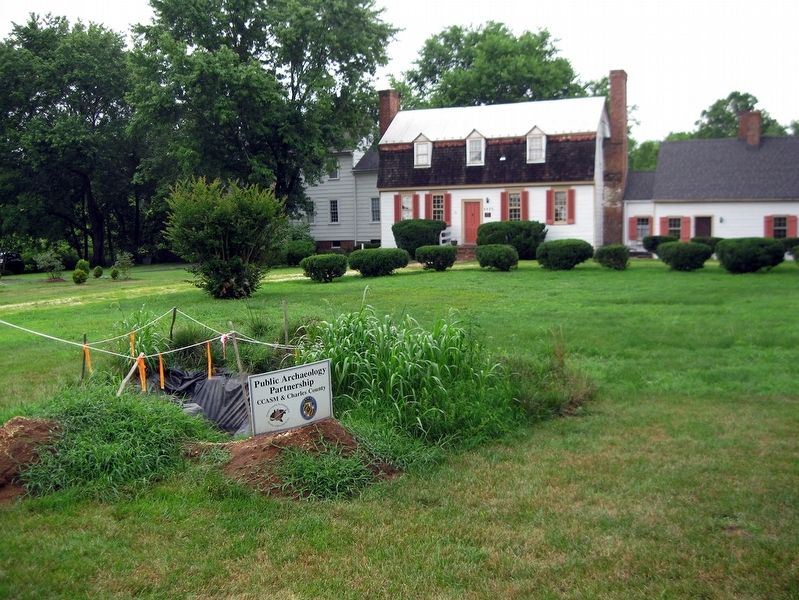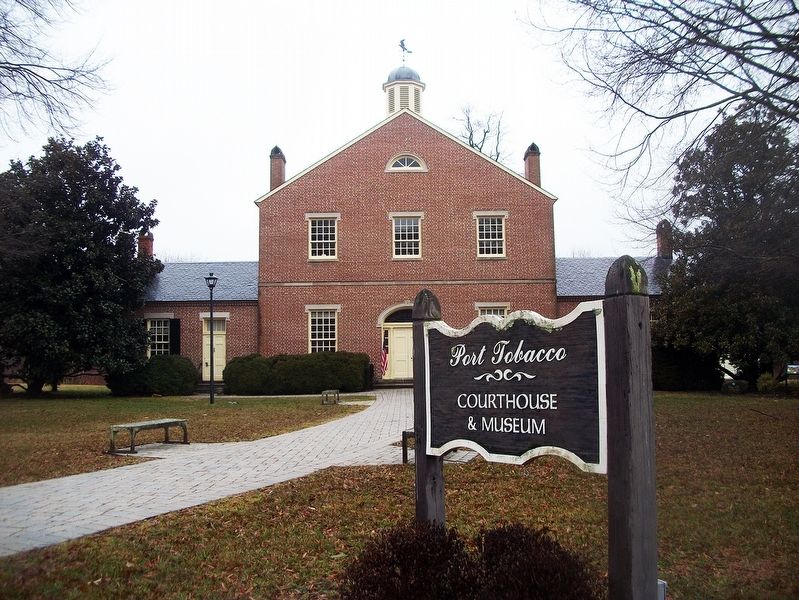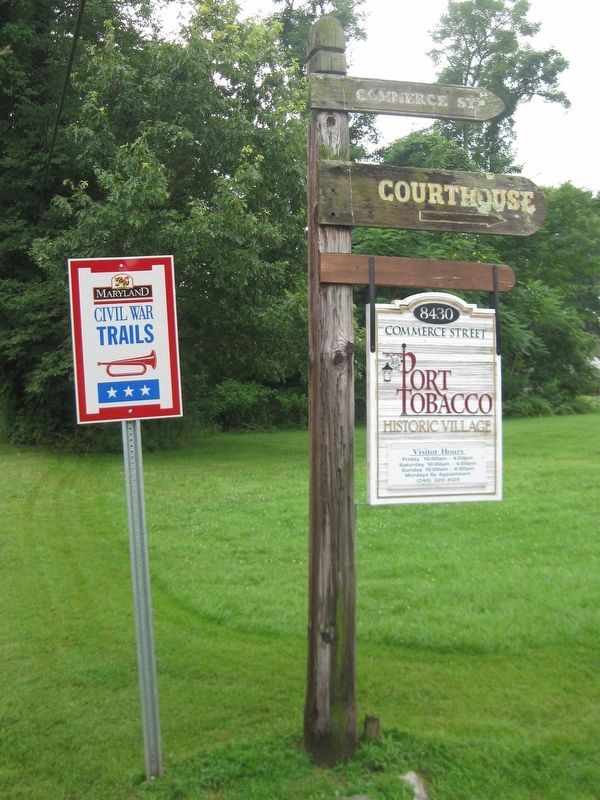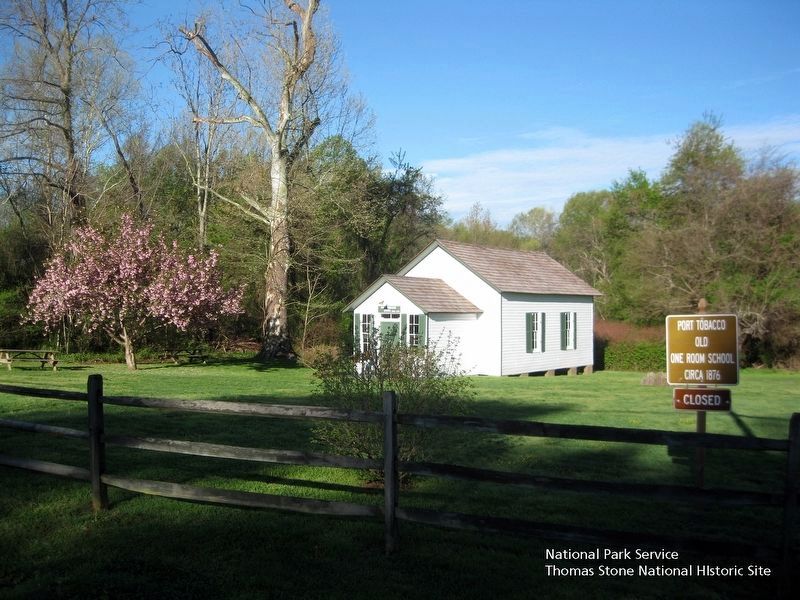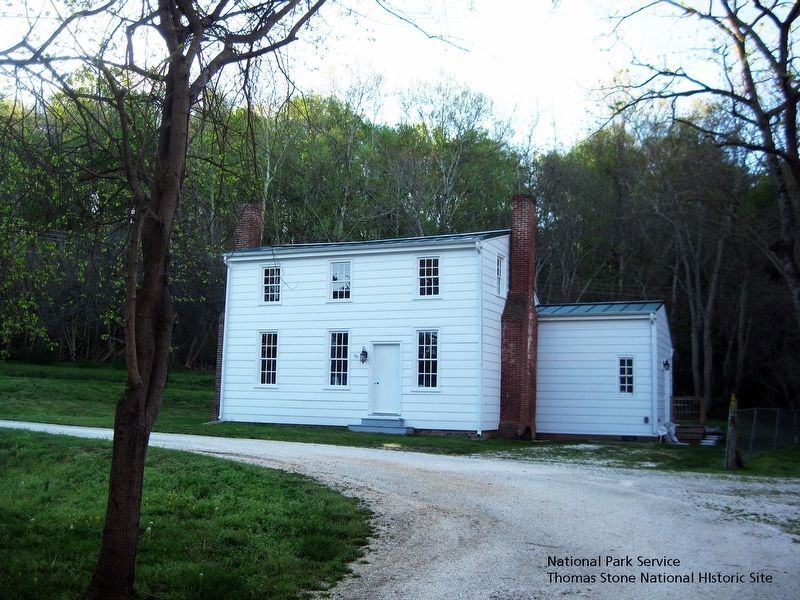Port Tobacco in Charles County, Maryland — The American Northeast (Mid-Atlantic)
Port Tobacco: Commerce
Inscription.
During the 17th century, local Indians often traded corn and deerskins to colonists for knives, steel needles, kettles, cloth, and beads. By the early 18th century, while most colonists dispersed across the countryside to farm the land, a few—particularly Scottish émigrés—settled in towns, operating stores out of their houses. Both Stagg Hall and Chimney House are surviving examples of merchant houses and stores. Stagg Hall was built ca. 1740 for merchant John Parnham.
Stagg Hall's well-preserved interior woodwork (left) and exterior make Stagg Hall an extraordinary example of early Colonial architecture. Extensively restored in the 20th century, Chimney House (the Barnes—Compton House) was built for merchant Thomas Ridgate in the late 1700s.
Scots factors (agents of merchant firms in Glasgow and Edinburgh) and English merchants (immigrants and American-born) sold European goods for cash and on credit to the Potobac Indians and to town residents and area farmers. Cash was hard to come by, so deerskins, tobacco, and other agricultural products and implements, and slaves secured credit. Many of the 18th and early 18th-century artifacts recovered from Port Tobacco were imported from Great Britain.
By the 1750s Scots factors had established an extensive network of stores along the Potomac River and sold European goods on credit in exchanged for tobacco, the cash crop throughout the Chesapeake. During the 1760s, Port Tobacco passed at least a million pounds of tobacco annually which was shipped to Britain, France, Holland, and Russia.
(Image of two structures.)
Chimney House and Stagg Hall, late 1800s.
(Image of Stagg Hall interior.)
Below the original interior woodwork at Stagg Hall was purchased by the Chicago Art Institute in 1932 where it remained on display until 1972. The late Robert Barbour purchased and reinstalled it in Stagg Hall.
(Image of one structure.)
Below, pictured around 1930, is Chimney House, noted for it impressive double-chimney with a three story pent. This type of chimney is a regional architectural feature of the late 18th and early 19th century.
(Map of Port Tobacco Village)
Yellow symbols below represent surviving historic buildings. Gray symbols are buildings that have disappeared since 1888.
(Inset with images of artifacts.)
Artifacts Unearthed
Above, Right, Italian or Dutch glass bead (Probable 17th or early 18th century) traded to the Potobac Indians for animal pelts or corn.
Left, A merchant or customer clipped this 1748-1759 Spanish dollar to make change,
Bottom left, Copper cent minted by the State of Connecticut between 1785 and 1789.
Right, tin-glazed punch bowl probably made in London, England in the 18th century.
(Four logos)
The Port Tobacco Archaeological Project
The Society for the Restoration of Port Tobacco • (301) 934-4313 • www.RestorePortTobacco.org
Charles County Maryland
Maryland Heritage Area
Erected by The Port Tobacco Archaeological Project, The Society for the Restoration of Port Tobacco, Charles County Maryland, Maryland Heritage Area.
Topics. This historical marker is listed in these topic lists: Agriculture • Colonial Era • Industry & Commerce • Native Americans. A significant historical year for this entry is 1740.
Location. 38° 30.667′ N, 77° 1.2′ W. Marker is in Port Tobacco, Maryland, in Charles County. Marker can be reached from Commerce St, 0.1 miles west of Chapel Point Road. Marker is on the left-hand side of the sidewalk connecting the parking lot and the Port Tobacco Courthouse. Touch for map. Marker is at or near this postal address: 8430 Commerce St, Port Tobacco MD 20677, United States of America. Touch for directions.
Other nearby markers. At least 8 other markers are within walking distance of this marker. Port Tobacco: Conspiracy & the Plot to Assassinate President Lincoln (here, next to this marker); John Wilkes Booth (a few steps from this marker); Port Tobacco (a few steps from this marker); On to Yorktown
(a few steps from this marker); Port Tobacco: A Maryland Mosaic (a few steps from this marker); St. Columba Masonic Lodge (within shouting distance of this marker); The Port Tobacco Jail (about 300 feet away, measured in a direct line); a different marker also named Port Tobacco (approx. 0.3 miles away). Touch for a list and map of all markers in Port Tobacco.
Also see . . . Port Tobacco Historic District. Maryland's National Register Properties website entry (Submitted on January 21, 2019.)
Credits. This page was last revised on January 30, 2024. It was originally submitted on January 21, 2019. This page has been viewed 265 times since then and 35 times this year. Photos: 1, 2, 3. submitted on January 21, 2019. 4. submitted on January 21, 2019, by David Lassman of Waldorf, Maryland. 5, 6. submitted on August 5, 2019. • Bill Pfingsten was the editor who published this page.
